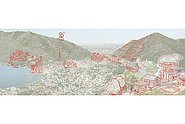7.3.2022 | Stephanie Kusma| News WSL
Using an innovative approach and historical data, researchers from the Swiss Federal Institute for Forest, Snow and Landscape Research WSL analysed changes in flora in the canton of Zurich. The spread of non-native plants revealed most about the underlying causes of these changes.
Changes in climate and land use favour some plant species and disadvantage others. Thanks to a unique data source, researchers from the Swiss Federal Institute for Forest, Snow and Landscape Research (WSL) and the University of Zurich have now been able to identify the winners and losers from these changes in the canton of Zurich.
Long-established wetland and nutrient-poor grassland plants have declined, while non-native species have done disproportionately well. Some 66% of these species, known as 'neophytes', became more widespread in the period between the historical and current surveys, compared with fewer than 10% of the native species.
Historical data: a stroke of luck ¶
"We were very fortunate that good data on historical flora existed for the canton of Zurich," says Thomas Wohlgemuth. The researchers were able to draw on a total of over 19,000 unique records from the period between 1900 and 1930. This allowed a direct comparison to be made with today's flora.
However, the comparison did not explain the reasons behind the changes. To pinpoint these, the researchers analysed the 'ecological indicator values' of the species concerned. These values describe the ecological requirements of a plant on a five-point quantitative scale.
"For example, 'one' indicates that the plant grows in places with cool temperatures, i.e. at high elevations, and 'five' means that the species likes very warm conditions," explains Wohlgemuth. As well as temperature, there are also indicator values for plants' moisture, light and nutrient preferences, among others.
Warmer, drier and more nutrient-rich ¶
For their study, Wohlgemuth and his colleagues calculated the average indicator values for different plant groups, such as native species and neophytes. The latter turned out to be the clearest indicators of the change in growing conditions in the canton, explains Daniel Scherrer, lead author of the study.
Their indicator values signal that they prefer warm, dry and nutrient-rich habitats. Their increased presence in parts of the canton with these conditions reflects the intensification of agriculture and the expansion of urban areas, as well as the associated drainage of many wetlands.
Clear climate signal ¶
However, the study also clearly shows that land-use change is not the only factor behind the neophytes' success. "The increase in neophytes has also been driven by warmer temperatures," says Scherrer. The researchers have therefore succeeded in detecting a climate signal in floristic changes in the lowlands. Until now, it has been difficult to separate the impact of climate from land-use change in these areas.
Comparing the indicator values and global distributions of neophytes and native species revealed a difference in their temperature preferences of approximately 1.8 °C. This roughly corresponds to the temperature increase of 2 °C recorded in the canton of Zurich since pre-industrial times.
"However, it isn't possible to establish a causal link here: many of the neophytes were already present before 1900 and others have only appeared in the last few decades," cautions Scherrer. "Even so, it's exciting that the numbers tally."
Contact ¶
Publications ¶
Scherrer D., Bürgi M., Gessler A., Kessler M., Nobis M.P., Wohlgemuth T. (2022) Abundance changes of neophytes and native species indicate a thermophilisation and eutrophisation of the Swiss flora during the 20th century. Ecol. Indic. 135, 108558 (11 pp.). https://doi.org/10.1016/j.ecolind.2022.108558Institutional Repository DORA
Wohlgemuth T., Del Fabbro C., Keel A., Kessler M., Nobis M., Spillmann J.H., Wyss G. (2014) Eine neue Flora des Kantons Zürich entsteht. Info Flora Plus. (2), 13-15. Institutional Repository DORA
Landolt E., Bäumler B., Erhardt A., Hegg O., Klötzli F., Lämmler W., … Wohlgemuth T. (2010) Flora indicativa. Ökologische Zeigerwerte und biologische Kennzeichen zur Flora der Schweiz und der Alpen. Ecological indicators values and biological attributes of the flora of Switzerland and the Alps. (2nd ed.). Bern: Haupt. 376 p. Institutional Repository DORA
Projects ¶
Copyright ¶
WSL and SLF provide the artwork for imaging of press articles relating to this media release for free. Transferring and saving the images in image databases and saving of images by third parties is not allowed.




